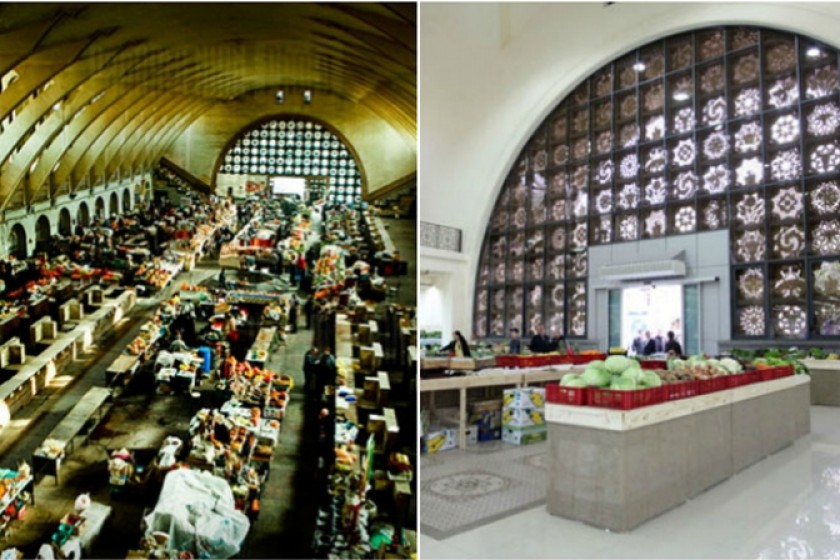
Yerevan’s Supermarkets & Big Box Stores: Squeezing Out the Little Guy
By Vrej Haroutounian
In recent years Yerevan has seen tremendous shifts in its urban planning.
In downtown Yerevan historic buildings are being demolished or retrofitted to create new business. The historically symbolic Farmers Market (Pak Shouka) has now been semi- demolished and replaced by the chain supermarket Yerevan City.
This building represented the ideology of equality. It was not placed randomly on one of the main arteriesof the city (Lenin Prospekt, now Mashtots Avenue).
It was placed there to show class equality and as an outlet for agrarian products which were a symbol of Armenia’s farmland and farmer, it created a connection between the city and the country in the material built form. When you visited the market you got to connect to the Armenia that was outside of Yerevan. You got to take home fruits, vegetables and other products that were grown in the provincesof Armenia. You were able to source local produce, sense a connection to these areas, and learn about their products and offerings.
Consumerism has its roots in Yerevan with the beginning of the period known as “the Thaw” which took place during the 1980s, as Soviet ideology was at its weakest and consumer goods were accessible via both soviet markets and the gray market that had developed.
In this period consumerism developed significantly until independence,when the economic collapse left people in dire straits.
Consumer stores are a critical aspectof Yerevan’s“Rabid” development years.
“Some new stores are built with better designs that are sensitive to the surroundings in choice of signage and coloring. Others simply paint over the touf stone, not understanding that the beauty in touf is in its physical form” (Interviewee, 2011).
“Overall, the stores that are located on the first floors of buildings and underground are a good change that is normal for a market economy and that make the city a lively place, with a more spontaneous feel” (Interviewees, 2011).
As downtown Yerevan becomes increasingly gentrified, there has been an increase in supermarkets throughout the city center, as the first floors of Soviet era buildings are converted into retail spaces, and the ground floors of new mixed developments are constructed. The supermarkets overwhelm the scale of traditional small-scale grocery stores, where farmers would bring their crops to sell in the city center.
The Pak Shouka, a central farmers market in downtown Yerevan, is an example of the polarizing effects of privatization. Several years ago, private land owners wished to convert the space into a supermarket.The project was temporarily project was halted by city officials, due to the lack of adequate permitting during construction, an issue brought to their attention by activists. Activists also pointed out the structure’s historical significance to the city’s identity. Needless to say, after many protests by concerned citizensthe project to convert the farmers market to a ‘Big Box’ Yerevan City was realized.
More supermarkets, with their larger target market area, also eliminate local shopkeepers through their greater purchasing power. Residents of neighborhoods are forced to travel further to purchase goods that were once readily available on the corner of their street. This phenomenon is also visible outside of the city center, in the presence of big box stores, which create the same effect and require the implementation of public transportation or personal automobiles to obtain goods for daily consumption.
Increased automobile congestion during peak hours can also be attributed to the Big Box stores which usually do not provide any private parking or adequately address the parking needs of shoppers. The front of such stores are usually used for double parking. This in turn creates congestion on major traffic arteries leading in and out of the city.
Historic markets add charm to all urban centers and are currently being implemented by progressive cities worldwide. Yerevan’s Pak Shouka farmers market should have been restored to its original function. It should have been redesigned with historic preservation in mind. All other markets in Yerevan should be regulated and zoned according to the needs of a neighborhood. Support for locally produced foods and products should be promoted with consideration for the ecological, economic, and societal benefits they provide. Small businesses should be supported and promoted as well.
Like many other sectors, supermarkets are another point where resources are becoming more centralized in the hands of the few. While some may argue that this is natural in a free market, others argue that there is no such thing as a free market given the fact that not all players in the market have the same access to resources, be they economic or political.
Nevertheless, the urban landscape of Yerevan reflects the truth clearly as it shifts in size and scale to adapt to the needs of capital at a specific point in time.
The costs resulting from such development - traffic congestion, reduction in the middle class and small business, increased automotive use, and public health issues - seem to be overlooked.
(Yerevan interviewee: This title is used for one of 20 anonymous experts interviewed during semi-structured interviews conducted in the summer of 2011)
Top photo: Fruit and veg sold at old Pak Shouka and today’s Yerevan City
 Videos
Videos Photos
Photos
Write a comment